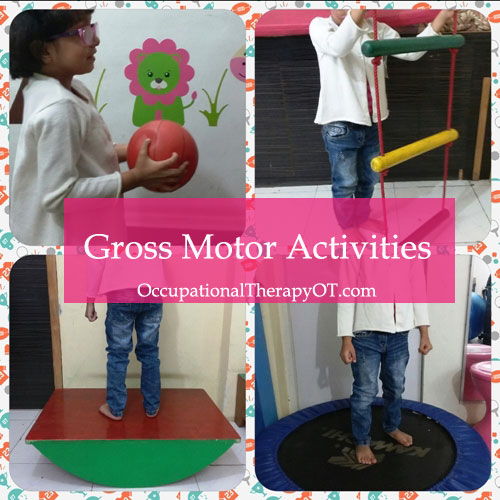Gross motor skills are the abilities to use the big muscles of the body for standing, walking, jumping, running and more. We start to learn these skills from the very beginning. Babies learn from neck control to side turning, crawling, sitting, and standing. As the babies grow, they learn to walk, run, and jump. They develop body balance; muscle strength and coordination of the different body parts. Gross motor skills are affected by the muscle tone, strength, and coordination.
Activities of daily living depend on the gross motor skills as well as on the Fine motor skills. Both of these skills help us to achieve our daily routine task.
If we are not able to develop gross motor skills or coordination between the gross and fine motor skills, we may depend on the others for self-care to occupational tasks.

Gross motor movements may be broadly categorized in 2 ways –
1. Locomotor Skills- as the name suggests, movement of a body from one place to another, this is very primary and most important developmental skills. Examples: Walking, running, climbing, jumping, hopping.
2. Non-locomotor skills – movement of a body in a stationary place. Example, seating, standing, bending, turning, pushing, pulling.
Gross motor skills Development –
The sequence of development is the same in all children, but the rate of development varies from child to child. Development progresses in the “Cephalocaudal” direction (means from head to toe). The first step towards walking is the development of head control – of strength in the neck muscles. The infant can do much with hands before he can walk.
Gross Motor skill development checklist –
Here we provide you some typical developmental milestone for the Gross motor skills. Please consider in mind, each child is different and there may be differences in acquisition of developmental milestone.
If you observe the delay in these patterns for more than 3-4 months, contact nearby occupational therapist/ other expert for early assessment and intervention. This checklist is basic in nature and may vary with an individual.
Click on the download button.
Download Gross Motor Checklist
Delay in gross motor development –
Use the normal development milestone checklist to find out the level or delayed in the gross motor development of the child. For example, if a one year old child is not able to hold his head erect, means there is a delay in gross motor development.
Reasons for delay in gross motor skill development –
Mental Retardation – Mental retardation affects gross motor skill development. Delay in the gross motor development depends on the degree of retardation or IQ.
Physical Handicap – Any disability in the lower and upper limbs affects the gross motor development of a child.
Prematurity – in case the child is born before completing nine months of pregnancy, gross motor skill development may be delayed.
Lack of Nutrition– lack of proper food during pregnancy and after childbirth affects the growth of a newborn child.
Lack of Stimulation – During infancy, if a child is left without proper care, and sensory stimulation, it may affect the child’s gross motor development.
When to train for gross motor skills –
There is no specific time to start. It is recommended that training should be started as early as possible if the developmental delay is noticed.
Go and seek the medical expert’s opinion and done the investigation as suggested by them. It’s better to find out the exact cause.
Conditions –
Most commonly, we can see delays in gross motor movements in many conditions, like Cerebral Palsy, Mental Retardation, and Paralysis. Conditions like ADHD, Autism may have a delay in gross motor, but more problems in their coordination of gross motor activities.
How to train –
First, find out the current level of the child using the gross motor skill checklist. For example, if he is able to sit without support, start training to sit without support.
Second, demonstrate the activity or exercise, and then, ask him to follow.
Motivate the child to perform the activity.
Appreciate his attempt at every step.
Initially, help the child physically to perform the activity. For example, If the child isn’t able to walk on a straight line (balancing issue), you may help him by providing minimal support. Gradually reduce the amount of physical help and train him to do it by himself.
Encourage him to use the skills he learned in everyday living – in the school, at home, and in the community.
Role of Occupational Therapist to encourage Gross motor skills-
Now, lets’s discuss about the role of an occupational therapist and how they help kids improve their skills by using different methods or activities.
Obviously, we (OT’ist) start with the assessment and then plan for the intervention.
An individual plan may be designed according to the need of a child. It may include exercises and functional activities to improve the gross motor skills.
Basic focus would be on the muscle strength and core stability, but not limited to,

OT sees the child as a whole and try to develop other necessary skills along with the gross skills
– Balance and coordination
– Strength and Endurance
– Attention and concentration
– Hand functions
– Body awareness
To achieve above mentioned objectives, OT uses many activities like –
– Walking in a straight line
– Obstacle walking
– Midline crossing activities
– Wheel barrow walking for upper body strength
– Ball Catching – throwing.
– One leg standing
– Jumping
– Hopping
– Theraband activities
– Climbing on the dynamic ladder.
– And many more
Click here for more Gross motor activities.





Leave a Reply